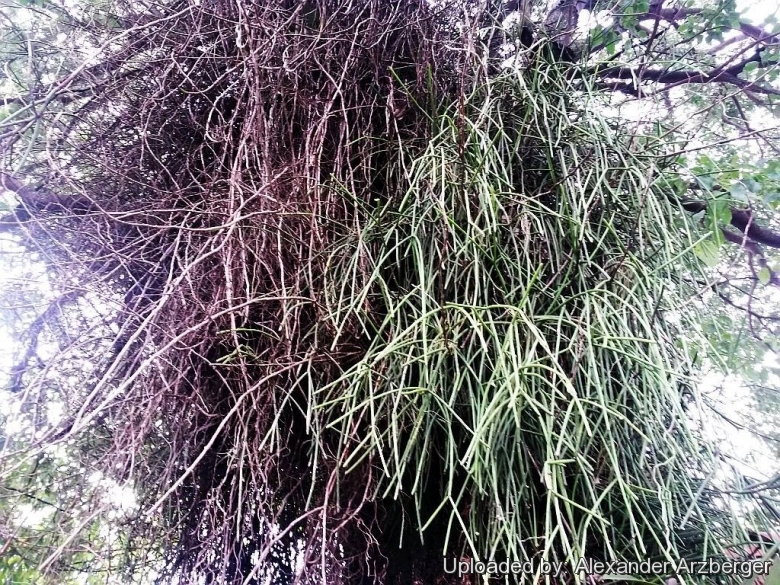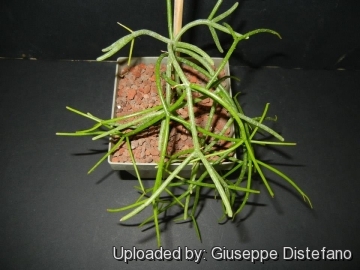Accepted Scientific Name: Rhipsalis baccifera (J.S.Muell.) Stearn
Cact. Journ. Brit. vii. 107 (1939)

Rhipsalis cassutha (Rhipsalis baccifera) Photo by: Alexander Arzberger
Vanda teres (oechid) and Rhipsalis baccifera growing epipyitically on a tree. Paraguay.
Origin and Habitat: Rhipsalis bacciferaSN|6426]]SN|6426]] is an extremely widespread species widely distributed in tropical America and the Caribbean. It can be found in Anguilla; Antigua and Barbuda; Argentina; Aruba; Barbados; Belize; Bolivia, Plurinational States of; Brazil (Bahia, Ceará, Maranhão, Paraíba, Pernambuco, São Paulo); Colombia; Costa Rica; Cuba; Dominica; Dominican Republic; Ecuador; El Salvador; French Guiana; Grenada; Guadeloupe; Guatemala; Guyana; Haiti; Honduras; Jamaica; Madagascar; Martinique; Mexico (Campeche, Chiapas, Hidalgo, Jalisco, Oaxaca, Puebla, Querétaro, Quintana Roo, San Luis Potosí, Tabasco, Tamaulipas, Veracruz, Yucatán); Montserrat; Netherlands Antilles; Nicaragua; Panama; Paraguay; Peru; Puerto Rico; Saint Kitts and Nevis; Saint Lucia; Saint Vincent and the Grenadines. United States (Florida – Native). The species also occurs in tropical Africa from the Ivory Coast to Ethiopia and as far south as South Africa, Seychelles, Mauritius, Reunion and Madagascar. It is also reported from Sri Lanka.
Altitude: It is found at elevations between sea level and 1,700 metres.
Habitat and Ecology: Rhipsalis bacciferaSN|6426]]SN|6426]] is an epiphytic or saxicolous cactus, usualty growing on trunk or branches of large trees, hanging in large clusters in a wide variety of habitats comprising low and medium elevation forests, rain forest, riverine forests and mangrove tidal swamp. It also grows in humus on shady rocks. This is the only cactus species naturally occurring outside the New World. One theory is that it was introduced to the Old World by migratory birds, long enough ago for the Old World populations to be regarded as distinct subspecies. The alternative theory is that the species initially crossed the Atlantic on European ships trading between South America and Africa, after which birds may have spread it more widely. Rhipsalis bacciferaSN|6426]]SN|6426]] is usually abundant where it occurs. The fruits atract birds, that spread the seeds, so the species can reproduce easy and fast, taking over trees in a large area. Given the huge range of this species, it is likely to be affected by a number of minor threats. However, none of these threats is significant enough to warrant any concern.
Synonyms:
See all synonyms of Rhipsalis baccifera
Common Names include:
ENGLISH: Pencil-cactus, Mistletoe-cactus, Mistletoe, Currant Cactus, Old Man's Beard, Spaghetti Cactus
FRENCH (Français): Cactus-gui
ITALIAN (Italiano): Cactus vischio
LITHUANIAN (Lietuvių): Uoginis ripsalis
PUNJABI Shahmukhi script ( پنجابی ): رہپسالس بیکیفرا
SWEDISH (Svenska): Korallkaktus
YORUBA (èdè Yorùbá): Igilligilli
Description: Rhipsalis bacciferaSN|6426]]SN|6426]] (also known as Mistletoe cactus or Spaghetti cactus) is a graceful epiphyte succulent with long thread-like stems and numerous creamy-white flowers followed by mistletoe-like fruits. It forms large hanging clusters, 1 to 4 metres long (occasionally up to 9 meters). Like most cacti it has succulent stems, however in R. baccifera these are weak, slender, narrow and pendent. It shows considerable polymorphism as a result of the existence of lots of geographically isolated populations and can be divided into numerous subspecies: the nominate subspecies, subsp. cleistogama M.Kessler, Ibisch & Barthlott, subsp. erythrocarpa (K.Schum.) Barthlott, subsp. hileiabaiana N.P.Taylor & Barthlott, subsp. horrida Baker) Barthlott, subsp. mauritiana (DC.) Barthlott; and subsp. shaferi (Britton & Rose) Bartlott & N.P.Taylor. Additional subspecies have been described in Africa and Madagascar. Rhipsalis bacciferaSN|6426]]SN|6426]] is the species most frequently grown.
Stems: Articulated, of indeterminate growth, very much branched dichotomously, or spirally, growing from tips of other branches, generally in pairs but sometimes in whorls of 6 or 8. The stems are weak and pendent 1-4 (or more) metres long; branches when young cylindrical, slender, not dimorphic, terete, sometimes producing aerial roots, 3-6 mm in diameter, light green, joints 10 to 20 cm. long, rarely up to 50 cm.
Areoles: Few dispersed, composite, with only 1-2 (or more) white tiny bristles to 1 m long. These bristly spines tend to disappear as the plant gets older.
Flowers: Borne laterally in winter or spring, solitary, small (5-10 mm in diameter), greenish in bud, sometimes subtended by a single bristle; petals 2 mm. long, cream-coloured; stamens borne on disk; ovary exserted.
Fruit: Naked, spheric, translucent, mistletoe-like, white or flesh-coloured (sometimes red), maturing a few days after flowering, globose, 5-8 mm. in diameter. The fruits are also edible, with a soft sweet taste.
Subspecies, varieties, forms and cultivars of plants belonging to the Rhipsalis baccifera group
 Rhipsalis baccifera (J.S.Muell.) Stearn: (subsp. baccifera) is mostly an epiphyte but at times a lithophyte, both diploid and tetraploid. Distribution: Caribbean, eastern Mexico, Florida, Central America, and northern South America.
Rhipsalis baccifera (J.S.Muell.) Stearn: (subsp. baccifera) is mostly an epiphyte but at times a lithophyte, both diploid and tetraploid. Distribution: Caribbean, eastern Mexico, Florida, Central America, and northern South America.- Rhipsalis baccifera subs. erythrocarpa (K.Schum.) Barthlott: is a tetraploid form. Distribution: it is found only in the mountains of east Africa.
- Rhipsalis baccifera subs. hileiabaiana N.P.Taylor & Barthlott: is very densely branched. Distribution: Bahia, Brazil.
- Rhipsalis baccifera subs. horrida (Baker) Barthlott: horrida is a neotenic form both epiphytic and lithophytic and has an aberrant branching pattern; it has
tetraploid and octoploid populations. Distribution: Madagascar.
- Rhipsalis baccifera subs. mauritiana (DC.) Barthlott: is a tetraploid form. Distribution: Old World, from tropical Africa east to Sri Lanka.
 Rhipsalis baccifera subs. shaferi (Britton & Rose) Barthlott & N.P.Taylor: has shorter,stiffer stem segments than subspecies baccifera . Distribution: Paraguay, southern Bolivia, and northern Argentina.
Rhipsalis baccifera subs. shaferi (Britton & Rose) Barthlott & N.P.Taylor: has shorter,stiffer stem segments than subspecies baccifera . Distribution: Paraguay, southern Bolivia, and northern Argentina.
Notes: R. baccifera, the only species of cactus to occur naturally outside the Western Hemisphere, is diploid in South America but tetraploid (2n = 4x = 44) in Central America, the Caribbean, SriLanka, and throughout Africa, and octoploid (2n = 8x - 88) in Madagascar.
Bibliography: Major references and further lectures
1) N. L. Britton, J. N. Rose: “The Cactaceae. Descriptions and Illustrations of Plants of the Cactus Family.” Volume 4, The Carnegie Institution of Washington, Washington 4: 7. 1923 [24 Dec 1923]
2) Edward Anderson “The Cactus family” Timber Press, Incorporated, 2001
3) James Cullen, Sabina G. Knees, H. Suzanne Cubey "The European Garden Flora Flowering Plants: A Manual for the Identification of Plants Cultivated in Europe, Both Out-of-Doors and Under Glass" Cambridge University Press, 11/Aug/2011
4) David R Hunt; Nigel P Taylor; Graham Charles; International Cactaceae Systematics Group. "The New Cactus Lexicon" dh books, 2006
5) Urs Eggli, Leonard E. Newton: “Etymological Dictionary of Succulent Plant Names” Springer, Berlin/Heidelberg 2010
6) Clive Innes “Complete Handbook of Cacti and Succulents” Van Nostrand Reinhold Company, 01/dic/1981
7) John Borg “Cacti: a gardener's handbook for their identification and cultivation” Blandford P., 1970
8) Brian Lamb “Letts guide to cacti of the world” Letts, 17/ott/1991
9) Sara Oldfield “Cactus and Succulent Plants: Status Survey and Conservation Action Plan” IUCN, 01/gen/1997
10) Arreola, H., Hammel, B., Hilton-Taylor, C., Ishiki, M., Loaiza, C., Nassar, J., Oakley, L., Pin, A., Taylor, N.P., Terrazas, T. & Zappi, D. 2013. Rhipsalis baccifera. In: IUCN 2013. “IUCN Red List of Threatened Species.” Version 2013.2. <www.iucnredlist.org>. Downloaded on 02 May 2014.
11) Innes C, Wall B. “Cacti, Succulents and Bromeliads.” Cassell & The Royal Horticultural Society. 1995
12) “Rhipsalis baccifera (J.S. Mueller) Stearn” in Cact. J. (Croydon) 7: 107 (1939). Rhipsalis, Lepismium, Hatiora, Schlumbergera. [Consulta: 2006-09-26].
13) Maxwell, Phil. “The Rhipsalis Riddle - or the day the cacti came down from the trees: Part 3”. in: New Zealand Cactus and Succulent Journal, May 1999.
14) J. H. Cota-Sánchez, M. Bomfim-Patricio “Seed morphology, ploidy and the evolutionary history of the epiphytic cactus Rhipsalis baccifera (Cactaceae).” In: Polibotánica. volume 29, 2010
15) Bandoni de Oliveiera et al. “Paleogeography of the South Atlantic: a route for primates and rodents into the New World?” 2009
16) Maxwell, P “The Rhipsalis Riddle.” 1999
17) Nobel, P.S. ed. “Cacti: Biology and Uses.” 1992
18) Cota-Sánchez, J.H & Bomfim-Patrício, M.C. “Seed morphology, polyploidy and the evolutionary history of the epiphytic cactus Rhipsalis baccifera (Cactaceae).” PoliBotanica. 2010
19) Barthlott W., Taylor N. P.“Notes towards a monograph of Rhipsalideae (Cactaceae). Bradleya” 13: 43–79. 1995
 Rhipsalis cassutha (Rhipsalis baccifera) Photo by: Giuseppe Distefano
Rhipsalis cassutha (Rhipsalis baccifera) Photo by: Giuseppe DistefanoSend a photo of this plant.The gallery now contains thousands of pictures, however it is possible to do even more. We are, of course, seeking photos of species not yet shown in the gallery but not only that, we are also looking for better pictures than those already present.
Read More... Cultivation and Propagation: Rhipsalis bacciferaSN|6426]]SN|6426]] is among the easiest to cultivate epiphytic cacti and tolerates neglect. These forest cacti tend to be long lived.
Exposure: This plant (as with all Rhipsalis) prefers partial shade.
Watering: It requires ample summer water (more than other cacti), but allow soil to dry slightly between waterings.
Soil: These cacti won't want a normal cactus soil but will prefer to be in a soil largely composed of organic material, such as peat or sphagnum moss, This type of soil would normally be used for orchids, bromeliads or other epiphytic plants.
These forest cacti tend to be long lived.
Hardiness: Frost tender. It needs night-time temperatures no cooler than 5° C, especially in the winter.
Special requirements: These plants bloom profusely if grown in an even, high temperature, but significantly less if the temperature fluctuates between 4°C and 18°C. They drop their buds easily if they are moved. Once flower buds have formed, do not move the plant, as slight changes in environment may cause the buds to drop.
Propagation: Stem cuttings.











